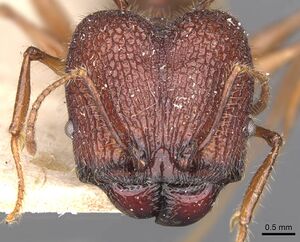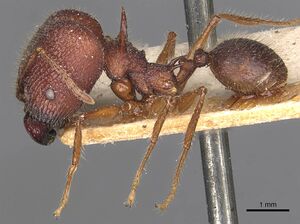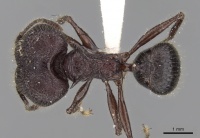Pheidole lokitae
| Pheidole lokitae | |
|---|---|

| |
| Scientific classification | |
| Kingdom: | Animalia |
| Phylum: | Arthropoda |
| Class: | Insecta |
| Order: | Hymenoptera |
| Family: | Formicidae |
| Subfamily: | Myrmicinae |
| Tribe: | Attini |
| Genus: | Pheidole |
| Species group: | quadricuspis |
| Species: | P. lokitae |
| Binomial name | |
| Pheidole lokitae Forel, 1913 | |
Nothing is known about the biology of Pheidole lokitae.
Identification
Eguchi et al. (2016) - Distinction from Pheidole leloi: In the major, promesonotal dome with a conspicuous transverse ridge on its posterior slope; ventral face of petiole without a longitudinal carina. In the minor, propodeal spine extremely long; petiolar node in lateral view blunt at apex.
Eguchi (2001) - P. lokitae is closely related to Pheidole quadrensis, Pheidole quadricuspis, Pheidole sperata, Pheidole acantha and Pheidole spinicornis, and several undescribed species (see under P. quadrensis), and they are recognisable among Indo-Chinese and Indo-Malayan congeners by a combination of the following characteristics: promesonotum of both the subcastes armed with a pair of long and acute spines; hypostoma of the major bearing a pair of stout median processes. P. lokitae, P. quadricuspis, P. quadrensis, P. acantha and P. spinicornis are known from Borneo, and are distinguished from each other by the characters given in the key.
Keys including this Species
- Key to Pheidole majors and minors of Borneo
- Key to Pheidole majors of Borneo
- Key to Pheidole minors of Borneo
Distribution
Latitudinal Distribution Pattern
Latitudinal Range: 3.2726° to 3.2726°.
| North Temperate |
North Subtropical |
Tropical | South Subtropical |
South Temperate |
- Source: AntMaps
Distribution based on Regional Taxon Lists
Indo-Australian Region: Borneo, Indonesia (type locality), Malaysia, Philippines.
Distribution based on AntMaps
Distribution based on AntWeb specimens
Check data from AntWeb
Countries Occupied
| Number of countries occupied by this species based on AntWiki Regional Taxon Lists. In general, fewer countries occupied indicates a narrower range, while more countries indicates a more widespread species. |

|
Estimated Abundance
| Relative abundance based on number of AntMaps records per species (this species within the purple bar). Fewer records (to the left) indicates a less abundant/encountered species while more records (to the right) indicates more abundant/encountered species. |

|
Biology
Castes
Worker
Minor
Images from AntWeb
   
| |
| Worker. Specimen code casent0281703. Photographer Estella Ortega, uploaded by California Academy of Sciences. | Owned by NHMUK, London, UK. |
   
| |
| Syntype of Pheidole lokitae. Worker. Specimen code casent0907767. Photographer Will Ericson, uploaded by California Academy of Sciences. | Owned by MHNG, Geneva, Switzerland. |
Major
Images from AntWeb
   
| |
| Syntype of Pheidole lokitae. Worker (major/soldier). Specimen code casent0907766. Photographer Will Ericson, uploaded by California Academy of Sciences. | Owned by MHNG, Geneva, Switzerland. |
Nomenclature
The following information is derived from Barry Bolton's Online Catalogue of the Ants of the World.
- lokitae. Pheidole (Pheidol acanthinus) lokitae Forel, 1913k: 46, figs. L, M (s.w.q.m.) INDONESIA (Sumatra). See also: Eguchi, 2001b: 69.
Unless otherwise noted the text for the remainder of this section is reported from the publication that includes the original description.
Description
Worker
Eguchi (2001) - Major (n=5): TL 6.0-6.3 mm, HL 2.55-2.74 mm, HW 2.79-2.91 mm, SL 1.46-1.54 mm, FL 2.15-2.21 mm, CI 106-110, SI 52-53, FI 76-79. Head broadest at about 3/5 distance of head (as measured from the mid-point of a transverse line spanning the anteriormost and posteriormost projecting points, respectively; posterior margin of head weakly concave medially (Fig. 24A); head in profile at most very weakly impressed on vertex (Fig. 24B). Hypostoma with a pair of stout median processes. Clypeus with a median longitudinal carina, with anterior margin emarginate medially. Eye situated just behind 1/3 distance of head; distance between mandibular insertion and anterior margin of eye 2.0-2.1 times as long as maximal diameter of eye. Frontal carina inconspicuous, extending backward to about midlength of head. Antennal scrobe present only around antennal insertion. Antenna with 3-segmented club; scape reaching about 2/3 distance of head; terminal segment 0.8-0.9 times as long as preceding two segments together. Masticatory margin of mandible with apical and preapical teeth, and a denticle in front of basal angIe. Promesonotal dome with a pair of spines, with a conspicuous prominence on its posterior declivity (Fig. 24C); the prominence in anterior view not or very weakly concave medially. Mesopleuron without a conspicuous transverse impression. Propodeal spine long, ca. 6 times as long as diameter of propodeal spiracle, almost straight or downcurved, with narrow base (Fig. 24C). Petiole cuneiform, 1.4-1.5 times as long as postpetiole (excluding helcium); petiolar node in profile round and in posterior view emarginate at apex; subpetiolar process completely absent. Postpetiole 1.9-2.1 times as broad as petiolar node.
Anterior part of frons, and gena longitudinally rugose, with smooth and shining interspaces; posterior part of frons, vertex, and dorsal and lateral faces of occipital lobe reticulate, with smooth and shining enclosures; alitrunk irregularly rugoso-reticulate; petiole smooth and shining anterodorsally, weakly rugose and weakly shining posterodorsally, and punctured and dull laterally; postpetiole punctured and dull laterally, and transversely rugose dorsally; dorsum of gaster and anterior part of first gastral sternite distinctly rugoso-punctured and dull. Outer face of mandible sparsely covered with appressed hairs, which are 0.10-0.12 mm in length and shorter than distance between piligerous punctures; submarginal zone of masticatory margin of mandible with a row of longer and decumbent hairs. Body dark reddish-brown with darker mandibles and gaster; legs a little lighter than alitrunk.
Minor (n=5): TL 4.0-4.4 mm, HL 1.16-1.24 mm, HW 1.04-1.11 mm, SL 1.59-1.70 mm, AL 1.74-1.83 mm, FL 1.89·2.02 mm, CI 89-90, SI 153-155, FI 181-183. Head in full-face view oval (Fig. 24D); occipital carina distinct. Clypeus with a median longitudinal carina, with anterior margin in full-face view weakly convex medially. Eyes situated at about midlength of bead; distance between mandibular insertion and anterior margin of eye 1.1-1.2 times as long as maximal diameter of eye. Frontal carina and antennal scrobe present only around antennal insertion. Antenna with 3-segmented club; in full-face view scape extending beyond posterior border of head by more than its 1/3 length; terminal segment ca. 0.8 times as long as preceding two segments together. Promesonotum forming a dome with a pair of spine, with an inconspicuous prominence on its posterior declivity (Fig. 24E). Mesopleuron without a transverse impression. Propodeal spine long, 5-6 times as long as diameter of propodeal spiracle, almost straight or downcurved. Petiole in profile cuneiform, ca. 1.5 times as long as postpetiole (excluding helcium); petiolar node in posterior view weakly emarginate at apex; its posterior face usually margined dorsally and laterally. Postpetiole 2.1-2.3 times as broad as petiolar node.
Clypeus smooth and shining with several rugulae; remainder of head, and alitrunk reticulate; petiole weakly punctured laterally, smooth and shining anterodorsally, and very weakly punctured posterodorsally; postpetiole weakly punctured laterally and very weakly punctured dorsally; gaster smooth and shining. Body sparsely bearing standing hairs. Body dark reddish-brown with lighter mandibles; antennae and legs lighter than alitrunk.
Type Material
Eguchi (2001) - Major, minor, queen and male (Musee d'Histoire Naturelle Genève). Type locality: Sumatra. Nine syntypes (3 majors, 3 minors and 3 queens) were examined.
References
- Eguchi, K. 2001a. A revision of the Bornean species of the ant genus Pheidole (Insecta: Hymenoptera: Formicidae: Myrmicinae). Tropics Monograph Series. 2:1-154.
- Eguchi, K. 2003. A Study on the Male Genitalia of Some Asian Species of Pheidole (Hymenoptera, Formicidae, Myrmicinae). Sociobiology 41(2): 317-355 (page 328, figs. 11A, B male genitalia described)
- Eguchi, K., Bui, T.V., Oguri, E. and S. Yamane. 2016. The first discovery of the "Pheidole quadricuspis group” in the Indo-Chinese Peninsula (Insecta: Hymenoptera: Formicidae: Myrmicinae). Revue Suisse de Zoologie. 123:45-55.
- Forel, A. 1913l. Wissenschaftliche Ergebnisse einer Forschungsreise nach Ostindien ausgeführt im Auftrage der Kgl. Preuss. Akademie der Wissenschaften zu Berlin von H. v. Buttel-Reepen. II. Ameisen aus Sumatra, Java, Malacca und Ceylon. Gesammelt von Her (page 46, figs. L, M soldier, worker, queen, male described)
References based on Global Ant Biodiversity Informatics
- Chapman, J. W., and Capco, S. R. 1951. Check list of the ants (Hymenoptera: Formicidae) of Asia. Monogr. Inst. Sci. Technol. Manila 1: 1-327
- Donisthorpe H. 1947. Pheidole (Pheidolacanthinus) striatus sp. n. from New Guinea, with notes on the subgenus Pheidolacanthinus F. Smith (Hym., Formicidae). Entomologist's Monthly Magazine 83:172-174.
- Eguchi K. 2001. A revision of the Bornean species of the ant genus Pheidole (Insecta: Hymenoptera: Formicidae: Myrmicinae). Tropics Monograph Series 2: 1-154.
- Eguchi K. 2003. A study on the male genitalia of some Asian species of Pheidole (Hymenoptera, Formicidae, Myrmicinae). Sociobiology 41: 317-355.
- Eguchi K., B. Tuan Viet, E. Oguri, and S. Yamane. 2016. The first discovery of the “Pheidole quadricuspis group” in the Indo-Chinese Peninsula (Insecta: Hymenoptera: Formicidae: Myrmicinae). Revue suisse de Zoologie 123(1): 45-55.
- Forel A. 1913k. Wissenschaftliche Ergebnisse einer Forschungsreise nach Ostindien ausgeführt im Auftrage der Kgl. Preuss. Akademie der Wissenschaften zu Berlin von H. v. Buttel-Reepen. II. Ameisen aus Sumatra, Java, Malacca und Ceylon. Gesammelt von Herrn Prof. Dr. v. Buttel-Reepen in den Jahren 1911-1912. Zoologische Jahrbücher. Abteilung für Systematik, Geographie und Biologie der Tiere 36:1-148.
- Pfeiffer M.; Mezger, D.; Hosoishi, S.; Bakhtiar, E. Y.; Kohout, R. J. 2011. The Formicidae of Borneo (Insecta: Hymenoptera): a preliminary species list. Asian Myrmecology 4:9-58



